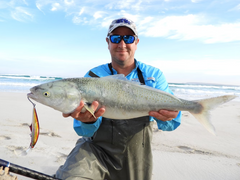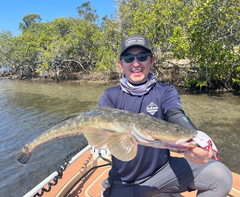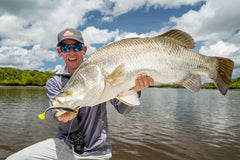Successful anglers employ various tricks to catch more fish, and one of the better-known ploys is to use berley. Whether you’re crouching on the end of a busy pier in Melbourne or drifting somewhere over the continental shelf, it’s always good to have the berley kit nearby, and those who do it well understand just how effective it can be.
In this blog we’ll look at what berley and berleying is, how to berley, when to berley, and a few tips and tricks to make it easier for you.
What is berley?
For those who don’t know, berley is any kind of fish attractant other than bait that the angler puts in the water to attract fish. Berleying can be as simple as throwing a few offcuts from your bait into the water, or it could be a handful of mixed substances thrown into the water at timed intervals, or even deploying a purpose-built berley cage full of a fish-attracting concoction.
The idea of berley is to bring fish from afar to the area where you’re fishing, with the ultimate goal being for the fish to eventually find your bait. Berleying can be an extremely effective way to bring fish to you, and when done well can even encourage fish to begin schooling around your berley trail.
Berleying isn’t just for bait anglers either, with lure and fly anglers also sometimes using this tactic to narrow their search – particularly in saltwater.
It is a little bit of extra effort, but in the right situations, it can turn a very slow day into an action-packed session.
When to berley
Berleying isn’t for every fishing situation. Modes of fishing that involve moving from spot to spot and actively searching for fish or fish-holding areas generally don’t call for berley. When fishing with lures or flies, in most instances the angler is moving around and looking for the fish, and this is why most non-bait fishers prefer to go without berley. Moving from spot to spot like this doesn’t give your berley trail time to start working properly.
If fishing with bait, or if fishing from one vantage with lures or flies, the angler is waiting for fish to come to them. This is when berley comes into play. Laying a good trail will speed up this process and bring fish to the area where they can be caught.
Common scenarios for berleying include, but are not limited to, fishing at anchor from a boat, fishing a beach gutter, fishing from a pier, fishing from the ocean rocks, or even just fishing land-based in a lake or estuary.
Current in the water is helpful, but not necessary, as this will allow your berley to be taken away from your position to reach fish that are further away. By keeping the stream of berley consistent, these fish can then swim up the trail to where your baits or lures are. Too much current can sometimes sweep a berley trail away before it starts working, so there is a balance.
How to berley
There is no one way to use berley, however, there are a few basic rules that most berley users tend to stick to, whether they’re berleying from the shore or out in the boat.
One of the most well-known rules of thumb is to make sure the fish are getting a little bit often. This means you want small amounts entering your stream of berley regularly. The idea is to whet the fish’s appetite, and not provide them with a proper feed, but be sure not to cut them off completely.
This can be done in several ways. Throwing in small bait offcuts or little handfuls of a pre-made mixture at regular intervals is a popular way to achieve this, particularly for land-based anglers.
Another way is to deploy a berley bag or cage packed with a solid berley material. Anglers then rely on the action of the waves or current to gradually dissolve the berley lump, allowing small pieces to break away and form the berley trail.
Some anglers even have built-in berley buckets attached to the stern of their boat, and will regularly drop items into the bucket and mash them up with a muncher to help it to break down and slowly disperse through the water column.
Some anglers will even attach small berley-dispersing products to their rig while they’re fishing.
Land-based
Berleying when you’re land-based can be a little extra effort, but well worth it if you need to attract fish to the area.
As mentioned, a very simple way to berley is to simply throw the scraps of your bait into the water as you bait up. This could be the shells of a prawn, the fatty bits of any meat, the crust of bread baits, and so on. This method is popular for minimalist anglers fishing from piers, breakwalls, and land-based estuaries.
For a more effective setup, berley bags are a great tool for the land-based angler, particularly for surf and rock anglers. Popular options include Jarvis Walker’s Net Factory Scaler Bag and pre-made mixtures such as McLaughlins Tuna Burley Log.
Those who want to go the extra mile can mix up a batch of their own bucket of berley and lob in handfuls at regular intervals. This is also popular with rock anglers. Common ingredients for homemade berleys include bran, tuna oil, pollard, bread or breadcrumbs, pet pellets, fish frames, pilchard chunks, wheat, corn, green weed, or sea cabbage and sand. A combination of two or more of these ingredients should attract something.

In the boat
Berleying from the boat is a little less fiddly, and there’s a few tricks you can employ to make a more effective trail. From the shore part of the difficulty comes from getting your berley out into deeper water, but out in the boat that isn’t an issue. Because of this, there’s a few extra options out in the boat.
While berley bags and homemade mixtures are a valid option in the boat, however berley cages, pots, and fixed berley buckets are more popular.
Berley cages and pots are small cages, made of either plastic or metal, that can be filled with a mixture and then dropped down to the desired depth, negating the need for any sinking agents in the berley. The Sea Dog Berley Bucket, Wilson Weighted Wire Burley Bucket, Frogley’s Offshore Burley Dropper, and Hook’em Berley Pot are perfect vessels for your berley that can be deployed to the desired depth. Some good pre-made mixtures you can buy for berley cages are the iCatch 1kg Burley Prawn Pellets, Aniseed and Tuna Nuggets, as well as Stimulate Pre Mixed Burley and Wilson Berley Pellets.

Wilson Berley 500ml Tuna Oil

Berley Pellets 650g

Sea Dog Berley Baskets
Other tricks
There are other little tricks and bits of kit to help your berley trail, and these can be called upon if you want to up your berleying game.
Berley bombs can be attached to a normal rig, and then cast and sunk down to where it’s needed. Berley bombs are particularly useful for land-based fishers who want their berley out deeper, but can also be used from the boat as well, especially if the current is strong and you don’t want your mixture to drift away too fast. The Black Pete Secret Weapon Berley Bomb is ideal for anyone wanting either of these things.
Can you smell it?
So there you go! Berleying can be as simple or as complicated as you like, and if done effectively can increase your chance of catching tenfold! One thing’s for sure, there’s nothing better than setting up your trail and being rewarded for your efforts when your desired target swims up it and scoffs one of your baits, lures or flies.
Next time you’re wondering how to get more fish to come to you, get some scent in the water and watch your catch rate soar!

Photo by Sebastian Hans on Unsplash

 Select Store
Select Store








